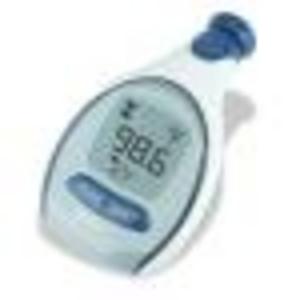When your child isn’t feeling well and has a fever it is important for you as the parent to try your best to comfort the child. Some children are very uncomfortable when they are running a high temperature, while other children act perfectly normal. As a parent, you need to know your child to properly access the severity of the illness.
First of all, you need to determine how high your child’s temperature. The most accurate way to take a young child’s temperature is rectally. While this is uncomfortable for both the parent and child, it is still the most accurate. If you prefer a different method, you can do an underarm reading, an oral reading, a tympanic reading (ear), or a temporal artery scan. Using a temporal artery scanner is the easiest route, and the method I would recommend. There is no discomfort for the child or the adult completing the scan. These thermometers are new to the market, but many stores such as Wal-Mart carry them for about $40. If you have young children I would highly recommend purchasing one. A child’s normal body temperature is 98.6 F. If you do an underarm reading, you will need to add one degree to the temperature to assess proper body temperature, or just let your doctor know you took the temperature underarm. Rectal temperature may be a little higher, but you need not take a way a degree. Oral will be right on, as will tympanic and a temporal artery scan.
Once you know your child’s temperature, you can further assess the situation. If the fever is higher than 100.4 F you will want to try some methods to bring the fever down. These include medicines, and other temperature reducing methods. One easy way to cool a child down is to place a cool, wet cloth on their forehead. This usually feels very comfortable to them and helps them to refresh. The cloth doesn’t need to be cold, or frozen, just wet the cloth with cool water and it will be cooler than your child’s body and draw away some of the heat. Another simple method to bring down your child’s temperature is a lukewarm bath. You will want to keep the water at least 90 F to avoid chills or cooling the child’s body too quickly. If the child starts to shiver, the body will raise it’s internal temperature causing the fever to rise even higher. This method is really best for very low grade fevers, often around 100 F. If your child’s temperature is above 101, I would suggest one of the other methods to assure the body does not react from it’s temperature changing so quickly. You can also try to undress the child to allow body heat to move away from the child. Remove any blankets or sweaters, but also watch for shivering which will cause the fever to increase. If your child seems uncomfortable or chilly, you can cover them with a light sheet. Giving your child lukewarm fluids may also help decrease their temperature, and assure the child does not become dehydrated. You can also try a Popsicle. Popsicles work well because they child usually eats it very slowly and your body can adjust in its own time. Ice water is not recommended as the child may guzzle it and then the liquid is still cold when in the child’s stomach.
If none of these methods bring down the child’s temperature it is time for some medicine. You can give acetaminophen to any child over 3 months, but you will need to consult your doctor for the proper dosing guide. Ibuprofen can be given once a child is 6 months, but you will also want to consult your doctor for dosing instructions. Aspirin is never recommended for children as it makes your child more susceptible to Reye’s syndrome, a rare and potentially fatal disease.
Some children’s bodies react to a high fever by having a seizure. These seizures are referred to as febrile seizures and are generally harmless. If you child begins seizing, be sure to lay them on their side and prevent them from falling or hitting any objects. The seizure should end in a few minutes, but you always need to consult a doctor and have them seen as soon as possible. If you child has trouble breathing, call 911 immediately.
A fever is a natural result of the child’s body trying to fight an infection of some sort. General fevers can be linked to a viral infection of some sort, although you may never know exactly what caused the fever. If the fever lasts for more than 2 days or is above 102, you should consult your physician and gain further instructions from them. Some fevers accompanied by other symptoms may be signs of a serious illness, and the doctor will need to assess the child.








